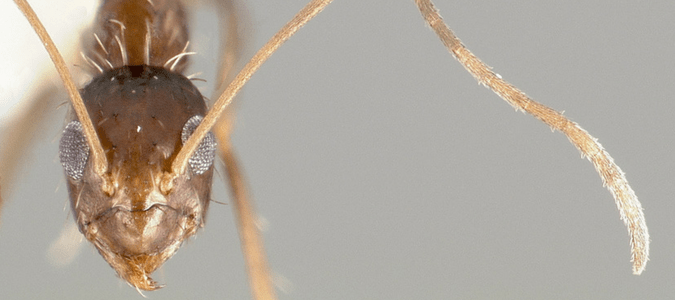
A new ant species has been discovered in the southern parts of the United States: the crazy ant. What’s important to know about these ants, which are also referred to by their scientific names, Nylanderia fulva (Rasberry crazy ant) and Paratrechina longicornis (the Longhorn crazy ant)? For starters, both of these ant species are not native to the United States, and both are considered pests.
Read on to learn what crazy ants are, how they got their name, what attracts them, and what impact they are having on humans.
What Are Crazy Ants?
Crazy ants were first discovered in 2002 in an industrial park outside of Houston. Exterminator Tom Rasberry noticed ants which were moving erratically and which caused significant damage to electrical equipment. “When you see fast-moving ants that are not following a path, they are probably crazy ants,” explained Randy McCarty, ABC’s Director of Training and resident entomologist, who has over 30 years of experience in pest control.
Crazy ants live in colonies which are one hundred times more dense than other ant species. In some areas, ants can be packed so tightly together that they can be mistaken for dirt. Another interesting story about crazy ants comes from Mike Foshee, who discovered these ants were the culprit when examining an air conditioner that was not working. When he used his Shop-Vac to clean the vent, he removed five gallons of crazy ants, all living in a small area.
These ant species first came to be known as Rasberry crazy ants, in honor of the entomologist who first described them, but now the most common species is known as the tawny crazy ant. Crazy ants have been found in 23 Texas counties and in all of the Gulf states. These ant colonies can move 650 feet a year, which is about the length of two soccer fields. Crazy ants can also be transported by hitching a ride on RVs, through garden products shipped by mail, and on plywood and hay bales.
Until recently, the Nylanderia ant species were grouped together with the genus Parathrechina. Researchers recently discovered enough distinctions between the two crazy ant species that these ants now are recognized differently from a scientific perspective. To the non-scientist, whoever, the ants are very similar.
Crazy ants can live both in homes and outside. Dark brown to blackish in color, the bodies of crazy ants can appear to have a bluish iridescence. The ant’s antennae are very long, and the body is covered with hair-like projections.
Worker ants can survive on a variety of food sources, including live and dead insects, seeds, fruits, and household foods. These ants are highly adaptable, and can be hard to control, since they forage far from their nest. Since crazy ants are a subtropical species, scientists believe these ants will not spread too far north.
Where Do They Come From?
Depending on the species, crazy ants are believed to have originated in South America, Africa, and Asia. Scientists theorize that the ants made it to the United States on ships.
One reason that we may be seeing more crazy ants in Texas and other parts of the country is that populations grow quickly. “Once you have a few colonies, they will multiply rapidly,” McCarty explained. “They reproduce more quickly than other ant species.”
What Attracts Crazy Ants?
Although crazy ants are often linked to electronics, scientists aren’t convinced that wiring, electrical outlets, and circuit boards provide a primary food source for these insects. A more likely explanation is that the ants release alarm pheromones when they receive an electrical shock when inside electrical equipment and that this attracts other members of the colony. Once enough ants sound off their virtual alarm systems, an infestation can quickly occur.
Outdoors, you can find crazy ants in areas where moisture is prevalent. “Any debris, landscape timbers, firewood, and leaf piles can attract these ants,” said McCarty. “Creek beds or areas by lakes see a larger population as well. We are noticing quite a bit in the Spicewood area near Austin.”
What Makes Crazy Ants Different?
What appears to be a crazy pattern of movement for these ants is actually an elaborate system to help transport heavy items. Workers change roles every 10 to 15 seconds, so a quick change from a leader to a scout may look strange, but in fact, this is a way to coordinate activity among what is essentially a very large family.
Unlike most ant colonies, which rally around one queen, crazy ants can have multiple queens within one colony. In fact, it is not uncommon to have eight queens in one nest. In some colonies, up to 100 queens have been found.
While most ants have a stinger, the crazy ant secretes a substance which can be sprayed at enemies, stopping them in their tracks. Crazy ants also produce a protective acid sheath which serves as a protective barrier against the venom of Texas’s most hated ant species, the fire ant. When crazy ants and fire ants compete for food, crazy ants emerge victorious 93% of the time. Without many natural enemies, it’s no wonder why we are seeing more crazy ants across the country.
Are Crazy Ants Harmful?
Unlike fire ants, the venom from crazy ants is not very toxic. After about a minute, the pain from a bite goes away. Although crazy ants don’t pack the punch of a fire ant bite, these insects can cause significant damage in nature. “Crazy ants can swarm and kill smaller animals and plants,” explained McCarty. “They will suck the juices right out of plants.” These ant species can displace virtually all other bug species – including spiders – and can even drive away songbirds. The reduction in the number of spiders and centipedes means less food for birds, which can cause more of a disruption in the ecosystem.
While fire ants tend to stay in one place, crazy ants are more nomadic. This different type of behavior means that homeowners are more at risk for damage to pipes, fuse boxes, or other cavities – even the inside of a car. In addition to damage to electronics and electrical systems, the ants have also been known to damage cell phones and televisions.
Crazy ants aren’t just a pest in homes and businesses. Studies have shown that these ant species can transport pathogenic microbes in hospitals.
How Can You Get Rid of Crazy Ants?
In 2013, The University of Texas announced a $2.7 million investment to research natural means to keep the crazy ant population in check. Scientists are looking at ways to control the fire ant population to see if any tactics also work on crazy ants. One possibility is introducing South American florid flies in areas where crazy ant infestations have occurred. Florid flies lay eggs on crazy ant heads. Once these eggs hatch, fly larvae feed on the crazy ant’s brain and crawl out of the insect’s skull, resulting in the death of the ant. Researchers are also testing a particular fungus on crazy ants to see if this biocontrol could prevent the spread of crazy ants without damaging other wildlife.
Since crazy ants are attracted to moisture, homeowners can check outdoor spaces to remove any plant debris, fallen limbs, and leaf litter which could provide a nesting spot for these creatures. Repairing links in irrigation systems and improving drainage can also help make yards less hospitable to crazy ants. Caulking around the exterior of a structure is another way to help prevent crazy ants from entering your home.
ABC Can Help Control Crazy Ants
Early detection may be the best form of prevention, as commercially-available chemical controls do not appear to be very effective in getting rid of these pests. “The key to successfully treating crazy ants is to treat the areas that you see them in multiple times,” stated McCarty. The pest control experts at ABC can help homeowners come up with a plan to stop the spread of crazy ants in and around your property and help provide relief from these tiny, but dangerous pests.
